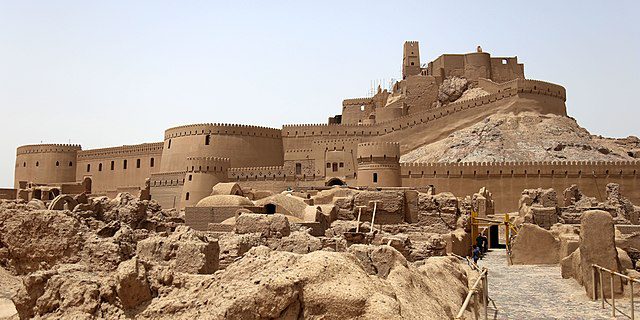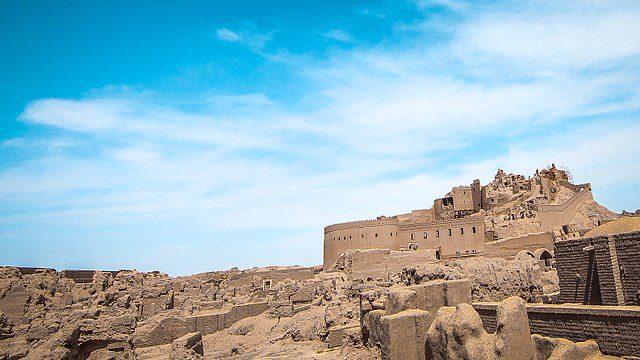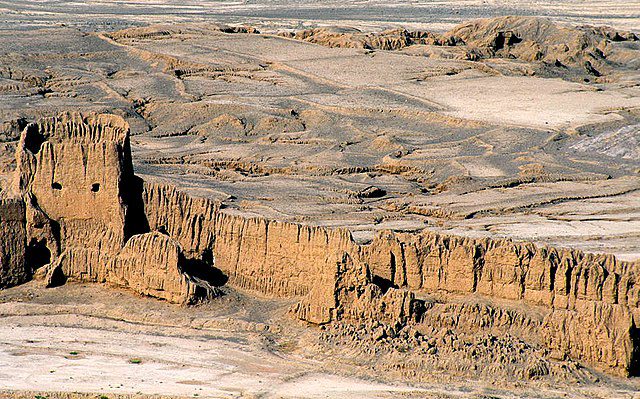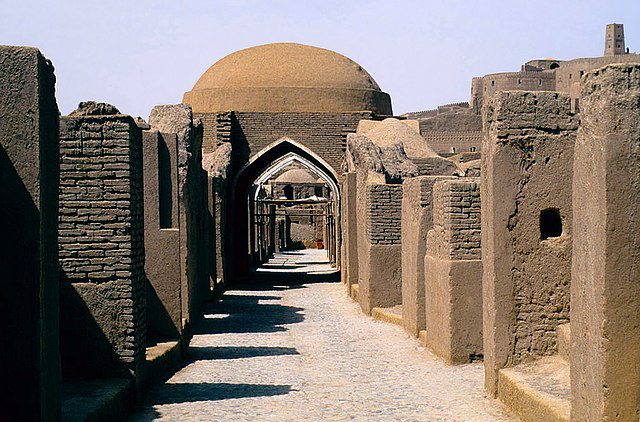Table of Contents
The ancient city of Bam (Arg-e Bam), a UNESCO World Heritage Site, dates back at least to the Achaemenid period, the sixth to fourth centuries AD. The heyday of Bam dates back to the seventh to eleventh centuries AD when it was located at the intersection of ancient trade roads. The city was inhabited from the Achaemenid period until 200 years ago. After that, and until about 80 years ago, it was used as a military base for soldiers.
The ancient city of Bam’s origin owes its construction to the creation of the Iranian groundwater supply system, the Kariz, and this system has been supplying water to the city up to now. Bam has two different conditions in terms of heights, one is the mountainous area which is a continuation of the central mountain range of Iran and the other is the low desert area which includes sand and salt marshes of the Lut desert and its surroundings. In the north of the current city of Bam, the historical citadel is located and is known as one of the largest brick buildings in the world.
Arg Meaning: The Origins of the Term
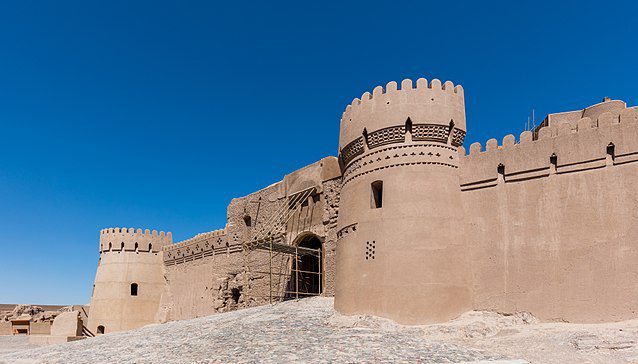
Arg is a type of tall and enclosed building that was used in ancient architecture. Arg literally means citadel. Citadels were like small castles in cities, with tall towers and strong walls. They weren’t just buildings; rulers lived and worked there, running the city.
In Iran, old citadels still stand, once home to leaders and centers of power. The word “citadel” comes from Pahlavi, meaning a strong fortress. These citadels weren’t just homes; they were hubs for kings, soldiers, and officials.
Archaeology shows that citadels in Iran appeared when cities did. While Greeks put their fortresses on hills and called them “Acropolis,” Iran’s citadels in Tehran and Shiraz sat on flat land, not on heights.
Citadels were city parts, not like castles, which were often separate and built for the military. These citadels aren’t just history; they’re symbols of Iran’s past.
Location of Arg-e Bam
The city is located between the southern part of the Lut Desert, the southern desert pit of Iran, and the northern part of the Barez Mountains, in southeastern Iran. The importance of the city of Bam has been due to its geographical location on a larger scale and its connection with the commercial centers of West Asia in ancient times.
Initially, the city, like other communities in the desert, was surrounded by protective walls. The governor lived in another part, in a castle inside the city. The whole enclosed city of Bam had an area of 200,000 square meters. Desert cities thus felt more secure and could grow better. Apart from this walled city and its castle, which is the central focus of the valley, Bam’s cultural landscape is linked to a group of forts that have now been destroyed.
Today in this city, you see a castle belonging to the seventh century AD, which is located in the north of Bam and is called Dokhtar Castle (Girl Castle). There are also shrines that date back to the 11th and 12th centuries AD – the tombs of Imamzadeh Asiri and Imamzadeh Zayd.
Different Parts of Arg-e Bam
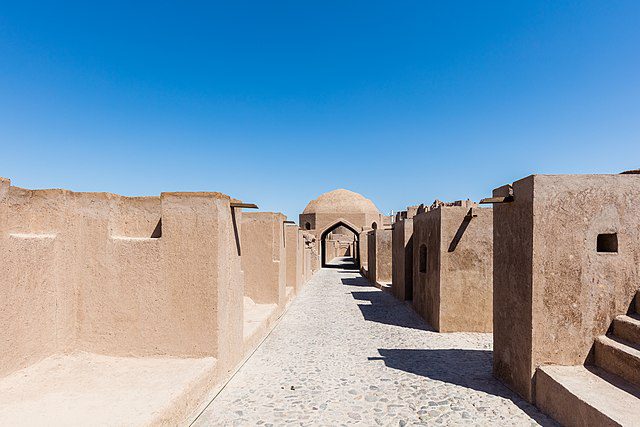
What makes the city of Bam special and unique in terms of its structure is the local technique used in its construction. Architects have traditionally used layers of mud (stratification), clay, and arched and domed structures. This is the best example of desert architecture that you can find in different parts of Iran around deserts. No matter which part of the city we visit, we see the same style and technique in all structures.
The enclosed and ancient city of Bam consists of 2 different parts for the ruler (castle) and ordinary people. The special ruling area is built on top of a cliff that is higher than other parts of the city and includes the royal stables, the barracks, and the ruling house. The ordinary area for the common people extends from the bottom of the ruling area to the city walls in a relatively flat area and includes everything a city needs. 528 residential houses, the main bazaar, square (reliance), Grand Mosque, Mirza Naeem School, Zurkhaneh, King Al-Tajjar House, caravanserai, public bath, Jewish Sabbath, and the house of a gentleman.
Bam Citadel: The Enchanting Ruins of the Past
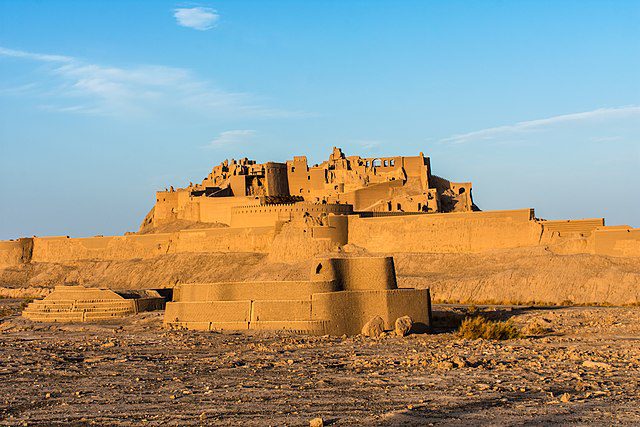
Bam Citadel, which was actually the same castle in the ancient times of Bam, is built in the northeast of Bam, on a high rocky slope with clay and mud. The history of Bam Citadel, according to historical writings, including Hudood al-Alam and the history of Vaziri, dates back to two thousand years ago.
Bam Citadel was still inhabited by some Bam residents about 180 years ago!
Bam Citadel complex, including the old city and the castle, was about 20 hectares (the length of the western side of the citadel is 520 meters and its width is 430 meters), and the distance between the citadel and the castle was about 6 hectares.
There were deep ditches around the castle that protected it from attacks. There were 38 watchtowers at regular intervals on the fortifications. In the middle of the castle, the ruling palace was built on a natural rock that had five floors, all made of clay and mud. The remaining columns and arches in Bam Castle, bakery shops, and brick shelves in the castle market show its past prosperity.
In the Islamic period, two mosques named the Jameh Mosque and the Mosque of Hazrat Mohammad and Hosseinieh, including a courtyard, a symmetrical two-story porch, and several rooms were built in the historic citadel of Bam, all of which were destroyed by the earthquake. In Bam Citadel, there was a Zurkhaneh in the style of other traditional stadiums with four porches, a dome, and a pit, which was also destroyed.
Bam citadel had only one entrance, the entrance arch of which was comparable to the arches of the Sassanid period. Lotfali Khan Zand was arrested in the same fort by Mohammad Ali Khan Zaboli, the ruler of the Bam fort. Bam citadel was inhabited until 1254 AH.
Arg-e Bam after Earthquake
In 2003, a massive earthquake struck Arg-e Bam, smashing 80% of this historical fortress to bits. It was a heartbreaking moment for Iran and the world, as this unique site teetered on the edge of disappearing forever. But in the midst of the wreckage, there was a glimmer of hope. President Khatami pledged to bring Arg-e Bam back to life, and what followed was an incredible story of human determination and teamwork.
Bam Citadel Reconstruction
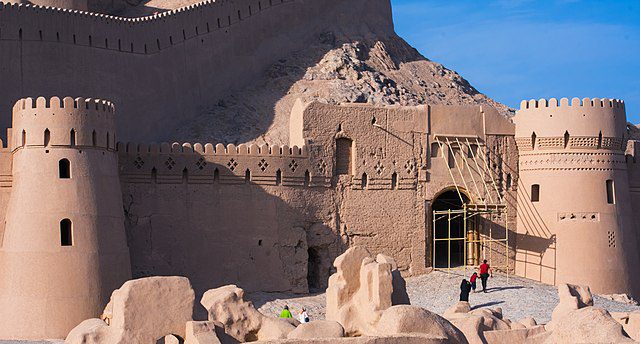
People from all over the world joined forces to save this UNESCO World Heritage Site. Countries like Japan, Italy, and France, along with others, teamed up with Iran. They all worked together to revive the ancient citadel. Today, thanks to this amazing cooperation, the government part of Arg-e Bam has been rebuilt and is now open for curious visitors.
This massive restoration project, which began with just a few countries, continued until 2020, showing that when people come together, they can overcome even the most daunting challenges. Arg-e Bam’s story reminds us of the incredible strength of humanity and the power of working together when faced with tough times.
Other Attractions near Arg-e Bam
Bam offers a rich tapestry of attractions, from serene desert landscapes to bustling bazaars. Here is the list of top attractions near Arg-e Bam:
Jameh Mosque (grand mosque) of Bam
Jameh mosque of Bam belongs to the beginning of Islam up to the Qajar period and this work was registered as one of the national monuments of Iran on August 17, 2003, with the registration number 9571. This mosque was built on the site of the former Zoroastrian fire temple with four porches and was later changed to three porches.
Zurkhaneh
The history of this sport in Bam dates back to 4000 years ago in the old Zurkhaneh of Bam. One of the sports etiquettes of Zurkhaneh is to enter the sports place with purity. In Bam Zurkhaneh, observing the raceway that was located before entering the Zurkhaneh and the athletes used it to purify themselves before entering the Zurkhaneh, it can be guessed that this Zurkhaneh belongs to pre-Islamic times.
Mirza Naeem School
Mirza Naeem School belongs to the Qajar period. This beautiful building is made of two parts, an internal part for teacher life and an external part for students to study. And this historical monument was registered on August 17, 2003, as one of the national monuments of Iran.
Darestan Hill
Darestan is an ancient hill 30 km east of the old citadel of Bam, which is 7 to 9 thousand years old. Darestan Hill is one of the earliest pre-pottery or non-pottery villages in southeastern Iran, which at its peak was abandoned for reasons unknown to archaeologists.
Among the artifacts discovered on this ancient hill, we can mention brick houses, metal tools, pottery, stone tools, and clay statues. One of the most interesting discoveries is the palm kernel, which shows the growth of this type of tree in 3500 BC in the city of Bam. This civilization represents the Halil River cultural area, and archaeologists have discovered artifacts from the Neolithic to the Bronze Age on the hill.
The city of Bam, despite the damage and destruction imposed on it, is still one of the most important cities in Kerman province in terms of attracting tourists. all these attractions have made this city have many sights. Above all, visitors travel to Bam to see historical attractions. Even in Ferdowsi’s Shahnameh and Ardeshir Babakan’s book, traces of Bam can be seen.
Traditional Bazaar of Bam
Bazaars are very important in terms of economic activities in all periods so we see the construction of bazaars in all cities of Iran and their remnants. Simultaneously with the beginning of urbanization in Iran, which dates back to 10 thousand years ago, and according to the need of people to buy necessities of life, bazaars were formed primarily in the form of exchange of goods for goods.
The traditional indoor bazaar of Bam is an economic gateway within the historic city of Bam. This bazaar is one of the historical bazaars of Kerman, which was completely destroyed due to the terrible earthquake in Bam, and now the repair and reconstruction of its shops are still going on.
The market was used to sell silk and cotton to traders who traveled to the area via the Spice Road, a branch of the Silk RoadThe market was used to sell silk and cotton to traders who traveled to the area via the Spice Road, a branch of the Silk Road.
How to Get to Arg-e Bam
By Car
If you’re traveling by car, your journey to Arg-e Bam is straightforward. Start by making your way to Rahimi Nejat Square, and from there, take a left onto Bahman Street. As you continue down Bahman Street, keep an eye out on your left, and you’ll soon spot the majestic castle.
By Bus
For those opting for a bus ride, begin by catching a bus from Kerman to Bam. Upon reaching Bam city, navigate to Rahimi Nejat Square. Once you’ve arrived at the square, simply make a left turn onto Bahman Street, and you’ll find the castle standing proudly on your left-hand side. It’s an easily accessible destination, ensuring your journey to this historic site is both convenient and memorable.
Recommended Sightseeing Time of Arg-e Bam
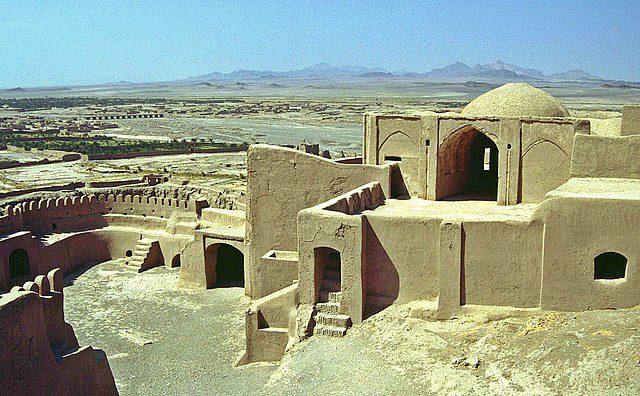
For an ideal Arg-e Bam experience, choose the cooler months of autumn, winter, or early spring. In the scorching desert heat of summer, this ancient citadel can be quite challenging to explore. However, during these off-peak seasons, you’ll find a more comfortable and serene environment.
Autumn blankets the landscape in warm colors, while winter adds a tranquil charm. In spring, the desert blossoms with delicate flowers. These times offer a unique opportunity to delve into Arg-e Bam’s history and marvel at its architecture without the relentless summer sun. Whether you’re an adventurer seeking solitude or a history buff, these seasons promise an enchanting and immersive visit to this desert gem.
Working Hours of Arg-e Bam
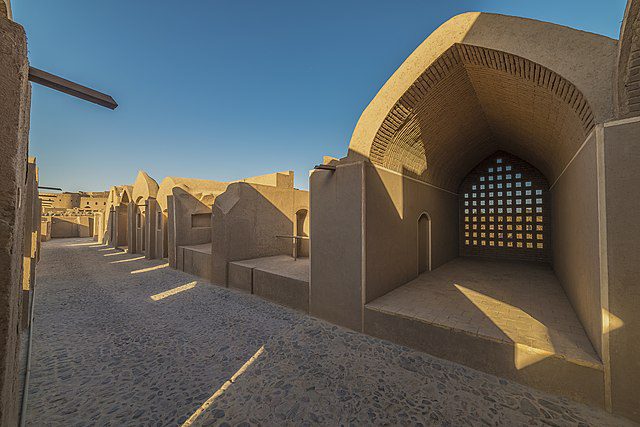
Arg-e Bam, the ancient fortress, welcomes visitors throughout the seasons. During Spring and Summer, it’s open from 7:30 in the morning until 7:00 at night, giving you plenty of daylight hours to explore. In the cooler months of Autumn and Winter, you can visit starting at 7:30 a.m., but the gates close at 5:00 p.m. when the days are shorter. Whether you prefer longer days of warmth or the cozier ambiance of the cold, Arg-e Bam is ready to show you its history and beauty.
Where to Eat near Arg-e Bam
Exploring the massive Arg-e Bam can work up an appetite. Luckily, you’ve got some great food options nearby. Langary Sandwich, Madar Fast Food, and Siah Va Sefid Pizza are all worth a visit. Langary Sandwich offers flavors that’ll take your taste buds on a journey, while Madar Fast Food serves up quick and satisfying bites. And if you’re craving pizza, don’t miss Siah Va Sefid’s cheesy delights. These spots not only satisfy your hunger but also let you savor the local flavors of the region. So, when you’re exploring Arg-e Bam, make sure to enjoy these tasty eats nearby.
Where to Stay near Arg-e Bam
Should you decide to extend your stay in Bam, you’ll find a range of accommodation options catering to various preferences. For the budget-conscious traveler, Bam Jahangardi Hotel offers affordable and comfortable lodging, ensuring you get a good night’s rest without breaking the bank.
On the other hand, if you’re in the mood for luxury and indulgence, both Bam Azadi Parsian Hotel and Bam Arg-e Jadid Hotel beckon with opulent amenities and top-notch service. These establishments provide an exquisite blend of comfort and extravagance, promising a memorable stay in this historic city. Whether you seek affordability or opulence, Bam has you covered when it comes to accommodations.
FAQs about Arg-e Bam
Q1: Where is Bam?
A1: Bam is situated roughly 115 miles (185 km) to the southeast of Kerman city. It sits at an elevation of around 3,600 feet (1,100 meters) along the banks of the Bam River.
Q2: How old is Bam in Iran?
A2: The beginning of the Bam Citadel, known as Arg-e Bam, dates back to the time of the Achaemenid Empire, which was around the 6th to 4th centuries BC, and possibly even earlier. The citadel flourished the most during the 7th to 11th centuries because it was strategically located at the intersection of significant trade routes and was renowned for making silk and cotton clothing.
Q3: What is the history of Bam?
A3: Bam’s roots go back to the time of the Achaemenid Empire, which was from the 6th to the 4th centuries BC.
Q4: What is Bam Iran famous for?
A4: Bam is a city located in the eastern part of Kerman province, Iran. This city serves as an important hub for agriculture and is situated along the historic Silk Road. It’s particularly famous for its extensive fortress, which was recognized as a UNESCO World Heritage site in 2004.
Q5: What is the largest adobe building in the world?
A5: The Arg-e Bam in Bam, Kerman Province, southeastern Iran, is the world’s largest adobe structure. Initially, it included both a citadel and a fortress, but now, the whole complex is called the Bam Citadel because the citadel is the most prominent remaining part.
Q6: What is the historical significance of the ancient city of Bam (Arg-e Bam)?
A6: The ancient city of Bam, or Arg-e Bam, dates back at least to the Achaemenid period (6th to 4th centuries AD) and reached its peak during the 7th to 11th centuries AD. It is known for its role as a hub on ancient trade routes and its unique desert architecture.
Q7: What led to the destruction of Bam Citadel in 2003, and how was it restored?
A7: Bam Citadel was severely damaged by a massive earthquake in 2003, resulting in an 80% destruction of the historical site. It was subsequently restored through international cooperation, with countries like Japan, Italy, and France partnering with Iran to rebuild the citadel.
Q8: Can you describe the different parts of Arg-e Bam’s structure?
A8: Arg-e Bam consists of two distinct parts: the ruling area, built on a high cliff and containing royal stables and barracks, and the ordinary area for the common people, situated in a relatively flat area within the city walls. The ordinary area includes various structures like residential houses, a main bazaar, and religious sites.
Q9: What is the recommended time to visit Arg-e Bam for the best experience?
A9: For the best experience, it’s advisable to visit Arg-e Bam during the cooler months of autumn, winter, or early spring. The scorching summer heat can make exploration challenging, but in the off-peak seasons, you’ll find a more comfortable and serene environment.
Q10: Where are some recommended places to eat and stay near Arg-e Bam?
A10: Near Arg-e Bam, you can enjoy local flavors at places like Langary Sandwich, Madar Fast Food, and Siah Va Sefid Pizza. For accommodation, options range from budget-friendly choices like Bam Jahangardi Hotel to luxurious ones like Bam Azadi Parsian Hotel and Bam Arg-e Jadid Hotel, catering to various preferences.
Unlock the Wonders of Arg-e Bam with Customized Tours
If you’re an adventurous traveler with a keen interest in exploring the unique marvels of the world, Arg-e Bam in Iran should be at the top of your bucket list. ToIranTour specializes in creating tailor-made Iran tours and travel packages designed to cater to your specific preferences and interests. Our team of seasoned professionals is here to help you craft an itinerary that ensures you have an extraordinary experience in Iran.
Contact us today, and let’s start planning your dream trip to Iran. We’re here to make your travel dreams a reality and ensure you have a truly immersive and memorable experience.

